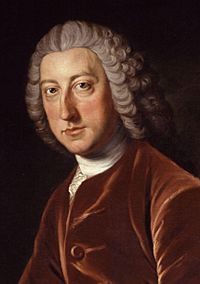Pitt–Devonshire ministry facts for kids
The government of Great Britain was under the joint leadership of William Pitt the Elder (in the House of Commons) and William Cavendish, 4th Duke of Devonshire (in the House of Lords), between November 1756 and April 1757—when Pitt was dismissed by King George. The King disliked Pitt, but Pitt's influence in the Commons had led to his crucial appointment as Southern Secretary in a ministry nominally headed by Devonshire.
Ministry
Principal ministers of the Crown were as follows:
| Portfolio | Minister | Took office | Left office |
|---|---|---|---|
| First Lord of the Treasury | The Duke of Devonshire* | 16 November 1756 | 1757 |
| Chancellor of the Exchequer | Henry Bilson-Legge | 16 November 1756 | 1757 |
| The Lord Mansfield | 13 April 1757 | 1757 | |
| Lord Privy Seal | The Earl Gower | 22 December 1755 | 1757 |
| Chancellor of the Duchy of Lancaster | The Lord Edgcumbe | 22 December 1743 | 1757 |
| Secretary of State for the Southern Department | William Pitt* | 4 December 1756 | 6 April 1757 |
| Secretary of State for the Northern Department | The Earl of Holderness | 23 March 1754 | 9 June 1757 |
| First Lord of Trade | The Earl of Halifax | 1 November 1748 | 1757 |
| First Lord of the Admiralty | The Earl Temple | 19 November 1756 | 6 April 1757 |
| The Earl of Winchilsea and Nottingham | 6 April 1757 | 1757 | |
| Treasurer of the Navy | George Grenville | 23 November 1756 | 1757 |
| Lord Lieutenant of Ireland | The Duke of Devonshire | 2 April 1755 | 3 January 1757 |
| The Duke of Bedford | 3 January 1757 | 1757 |
See also

All content from Kiddle encyclopedia articles (including the article images and facts) can be freely used under Attribution-ShareAlike license, unless stated otherwise. Cite this article:
Pitt–Devonshire ministry Facts for Kids. Kiddle Encyclopedia.


